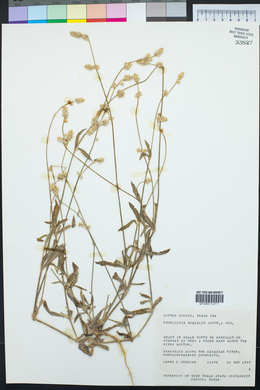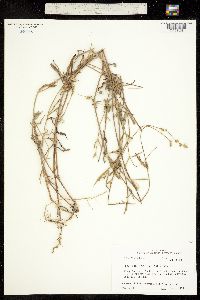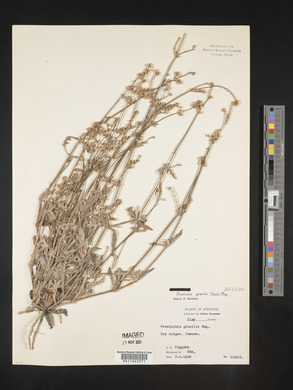Froelichia gracilis
|
|
|
|
Family: Amaranthaceae
Slender Snake-Cotton
[Froelichia braunii Standl., moreOplotheca gracilis Hook.] |
Plants annual or short-lived perennial; taproots narrow, enlarged when perennial, semiwoody. Stems several (rarely 1), erect or ascending, sometimes procumbent, usually much-branched from base, slender, 1-5(-10) dm, densely or sparsely villous-tomentose with grayish white hairs. Leaves predominant on proximal 1/3 of plant, often basal, sessile; blade linear to lanceolate or lance-elliptic, largest leaves 1.6-9(-13.5) × 0.2-0.9(-1.2) cm, base acuminate or attenuate, apex acute to acuminate, canescent or sericeous adaxially, sericeous-tomentose with white or gray hairs abaxially. Spikes sparsely branched, flowers arranged in 3-ranked spiral; bracteoles stramineous or blackish, glabrous. Flowers 2.4-3.8 mm; perianth lobes oblong-linear, apex acute or acutish, pubescence grayish; filament lobes stramineous or blackish, blunt. Utricles 2.5-5 × 2.7-4 mm, apex slightly oblique, with irregularly and deeply cut ('spiny') lateral wings, both surfaces of perianth with distinct spines or tubercles. 2n = 54. Flowering summer in north, year-round in extreme south. Open plains, rocky hillsides, roadsides, waste ground, railroad ballast; Ont.; Ala., Ariz., Ark., Calif., Colo., Conn., Ga., Ill., Ind., Iowa, Kans., Ky., La., Md., Mass., Mich., Miss., Mo., Nebr., N.H., N.J., N.Mex., N.Y., N.C., Ohio, Okla., Pa., S.C., Tenn., Tex., Va., W.Va., Wis.; Mexico (Chihuahua, Coahuila, Nuevo León, Tamaulipas); introduced in Europe; Asia (Japan). The current range of Froelichia gracilis is due in large part to its introduction via railroads during the past 100 years, and the majority of records for the species east of the Mississippi River occur on or near railroads. S. F. Blake (1956) discussed this eastern spread of the species. Froelichia gracilis is considered a minor invasive weed in the Northeast; its adaptation to open sandy or gravely soils will restrict its spread to open sites with poor soil. In regions where their ranges overlap, Froelichia gracilis may hybridize with F. floridana. Plants with intermediate form from Texas and the Midwest have been noted. Suspected hybrids appear closest in habit to F. gracilis and will generally key to that species. Floral structure will be intermediate and variable; the branching will be typically less than in F. gracilis and present distal to the base.
FNA 2004, Kearney and Peebles 1969, McDougall 1973 Duration: Annual Nativity: Native Lifeform: Forb/Herb General: Herbaceous annuals or short-lived perennials, to 50 cm tall, stems slender, sparsely to densely tomentose with silky, grayish hairs, much branched from the base, the branches ascending to decumbent, plants sometimes with a thickened taproot and woody base when the plant is perennial. Leaves: Opposite, thin, simple, narrowly oblanceolate to elliptic, acute to acuminate at the tip, cuneate at the base, the margins entire, to 5 cm long and 1 cm wide, blades borne on short petioles, leaf surfaces sparsely tomentose, more so below, leaves becoming more numerous towards the base. Flowers: Perfect, (appearing like white cottony tufts with dark tops at branch tips), calyx 5-lobed, the lobes glabrate, tubes lanate, with subtending bracts straw-colored or brown to nearly black, stamens 5, filaments united into a tube, the flowers arranged in a 3-ranked spiral, these borne in axillary or terminal panicles or interrupted spikes, 1-3 cm long, which become woolly with maturity and appear dotted at the tips with the dark bracts. Fruits: Indehiscent utricles, to 5 mm long and 4 mm wide, with somewhat spiny lateral wings, the fruits included within the tubes formed by the united filaments. Ecology: Found on open plains, rocky hillsides, roadsides, waste ground, and railroad ballast, from 4,500-5,500 ft (1372-1676 m); flowering in summer. Distribution: Ontario, west to South Dakota, Wyoming, and Colorado, south to California, Arizona, Texas, extending east to Florida. Not present in Nevada or Utah. Notes: The dark tips of the bracts in the cottony flowers make this species easy to identify when in flower. Kearney and Peebles have the keys to this species as its annual habit, slender stems, and thin lanceolate leaves, which contrast with the more robust and thick-leaved F. arizonica. Ethnobotany: Unknown Etymology: Froelichia honors German physician and botanist Joseph Aloys von Froelich (1766-1841), while gracilis means slender, graceful. Synonyms: Froelichia braunii, Oplotheca gracilis Editor: LCrumbacher 2011 Slender, erect to nearly prostrate, commonly branched from near the base, 2-7 dm; lvs mostly below the middle of the stem, linear to narrowly lanceolate, the larger ones to ca 8 נ1 cm; spikes 1-3 cm; fls in a 3-rowed spiral, avg 6-10 per cm; mature cal obliquely conic, mostly 3.5-4 mm; seeds 1.2-1.4 mm; otherwise much as in no. 1 [Froelichia floridana (Nutt.) Moq.]; 2n=54. Dry soil; Ind. to Io. and Colo., s. to Ark. and n. Mex.; adventive especially along railroad-tracks e. to s. Ont., Mass., and S.C. July-Sept. Gleason, Henry A. & Cronquist, Arthur J. 1991. Manual of vascular plants of northeastern United States and adjacent Canada. lxxv + 910 pp. ©The New York Botanical Garden. All rights reserved. Used by permission. From Flora of Indiana (1940) by Charles C. Deam In 1930 I found a few plants of this species along the Chicago & Eastern Illinois Railroad at the Duncan Switch about 4 miles south of Vincennes. The soil along the railroad here is almost a pure sand. By the fall of 1933 it had spread for a quarter of a mile and formed a complete stand at the switch and for several hundred feet to the north of it. This species will probably become a weed in the sandy area of this part of the country. In 1933 I found two small colonies in ballast along the railroad in the first mile east of Dana, Vermillion County. In 1933 Paul Weatherwax found a large colony in ballast along the railroad half a mile south of Worthington, Greene County. In 1937 Charles M. Ek found scattered plants in cinder soil in the railroad yards in Tipton, Tipton County. Doubtless it already has a much wider distribution in the state than our records show. ...... Indiana Coefficient of Conservatism: C = 0 Wetland Indicator Status: UPL Diagnostic Traits: plants rarely more than 50 cm tall; stems and leaves with white-wooly hairs; leaves opposite, linear-lanceolate; inflorescences spicate; bracteoles glabrous. |
|
|
|






















































































